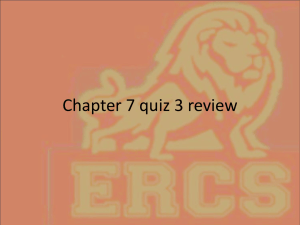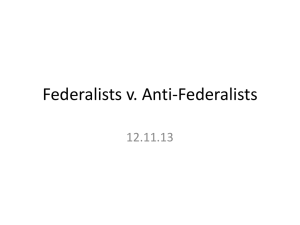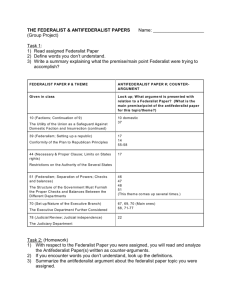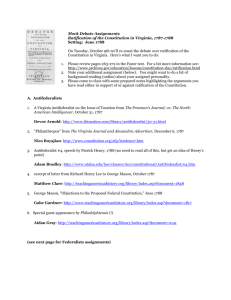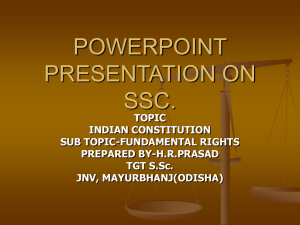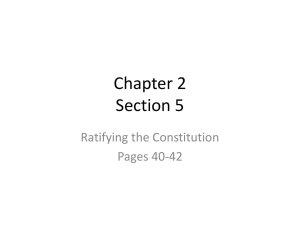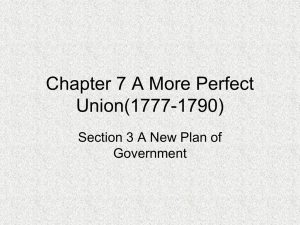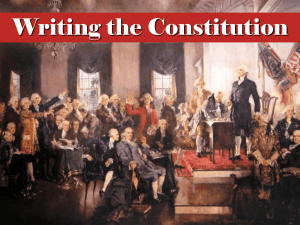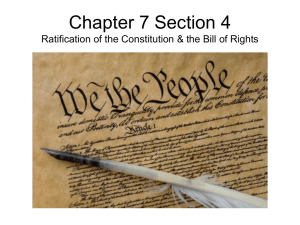Constitution Debate and Directions
advertisement
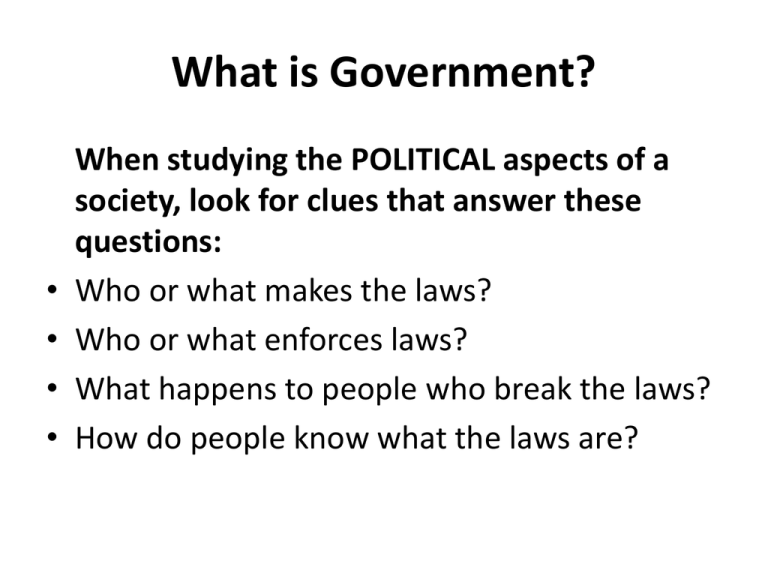
What is Government? • • • • When studying the POLITICAL aspects of a society, look for clues that answer these questions: Who or what makes the laws? Who or what enforces laws? What happens to people who break the laws? How do people know what the laws are? The Constitution Debate Approach (3 C’s) • Context (Timeframe, Timeline, Place in history or historical study) • Content (Historical narrative: What is happening? Who is involved? What are their arguments?) • Conclusions (What is going on here? What are the resolutions? What are the “ripple effects” or unintended consequences?) Context • 1777: Articles of Confederation (Key points—loose confederation, wary of central government, gave the United States no real power over the united states, no executive, no ability to tax). Ratified in 1781. • 1787: Constitutional Convention (initially met to revise the Articles, ended up writing a whole new document. Many questioned the legality of doing such a thing.) • 1787-1788: Constitutional Debates • 1789-1797: George Washington, 1st President (Federalist) • 1790: Rhode Island finally ratifies the Constitution, bringing an end to the Constitutional Debate. • 1791: First ten amendments to Constitution • 1797-1801: John Adams, 2nd President (Federalist) (Thomas Jefferson, VP) • 1801-1809: Thomas Jefferson, 3rd President (Republican) Federalists and Antifederalists • Read the text on your notecard. • Underline or highlight the argument. • What is the author of the quote trying to convince his audience? • Is your author a Federalist (For ratification of the Constitution or Antifederalist (Against ratification of the Constitution)? Note card Practice • "The most considerable of these remaining objections is that 2) the plan of the convention contains no bill of rights." "Bills of Rights are, in their origin, stipulations between kings and their subjects." The "We the people" clause in the Preamble to the Constitution "is a better recognition of popular rights. A bill of rights would sound much better in a treatise of ethics than in a constitution of government." "Bills of Rights are not only unnecessary in the proposed Constitution but would even be dangerous." “It meets two vital objects of a bill of rights: it 1) declares and specifies "the political privileges of the citizens in the structure and administration of the government," and 2) defines "certain immunities and modes of proceeding, which are relative to personal and private concerns." (May 28, 1788) Underline Argument • "The most considerable of these remaining objections is that 2) the plan of the convention contains no bill of rights." "Bills of Rights are, in their origin, stipulations between kings and their subjects." The "We the people" clause in the Preamble to the Constitution "is a better recognition of popular rights. A bill of rights would sound much better in a treatise of ethics than in a constitution of government." "Bills of Rights are not only unnecessary in the proposed Constitution but would even be dangerous." “It meets two vital objects of a bill of rights: it 1) declares and specifies "the political privileges of the citizens in the structure and administration of the government," and 2) defines "certain immunities and modes of proceeding, which are relative to personal and private concerns." (May 28, 1788) Determine the Argument • A Bill of Rights is unnecessary because the Constitution already outlines the privileges of citizens and it outlines immunities which they may receive in relation to personal and private concerns. • Is he a Federalist or Antifederalist? Is he a Federalist or Antifederalist? • Federalist • Because he believes the Constitution, as it is written, does not need a Bill of Rights added to it. Note Taking • On the back of your note card, make TWO columns. • Column I is FOR (Federalist) and Column II is AGAINST (Antifederalist) • Write student responses from your convention in the For or Against column. Convention Protocol • Approach as many students in the class as you can. • Ask each student individually, “What do you think of this new document, the Constitution? Why?” • In all encounters, explain the argument on your note card (summarize). When you ask another student, you cannot give YOUR opinion. You can only give YOUR opinion when you are asked. • You will need to go to another student before continuing your exchange with the student who initially asked your opinion. Wrap Up • Divide into Federalist and Antifederalist groups. • What were the positions of the Federalists and Why? • What were the positions of the Antifederalists and Why? • The Constitution set up the Federal system: What were the characteristics of the federal system based on the arguments presented in class today?
